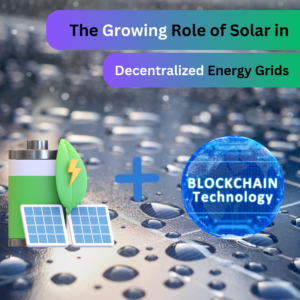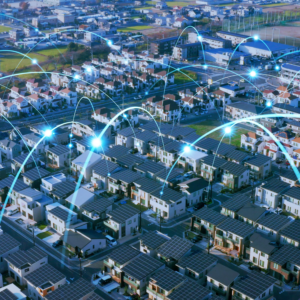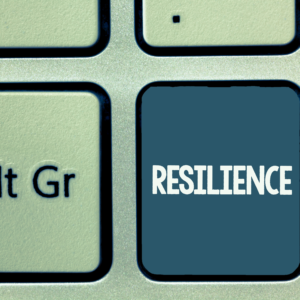The Growing Role of Solar in Decentralized Energy Grids
The world is undergoing a significant transformation in the way energy is produced and consumed. Traditional centralized energy grids, where power is generated at large plants and distributed across vast networks, are being challenged by the rise of decentralized energy systems. These systems rely on local generation sources, such as solar power, to provide electricity directly to consumers. As solar technology continues to evolve and become more affordable, it is playing an increasingly crucial role in shaping these decentralized grids, offering benefits that include energy independence, environmental sustainability, and enhanced resilience.
 What Are Decentralized Energy Grids?
What Are Decentralized Energy Grids?
Decentralized energy grids, also known as microgrids, are smaller, localized networks that can operate independently or in coordination with the larger grid. These grids are designed to use distributed energy resources (DERs) such as solar panels, wind turbines, and battery storage systems to generate and store electricity. Unlike traditional energy grids that rely on a central power source, decentralized grids enable users to produce their own energy locally, reducing transmission losses and increasing system reliability.
The concept of decentralized grids is gaining traction due to its potential to address energy challenges, such as energy access, reliability, and sustainability. By shifting from a one-size-fits-all model to more localized, flexible, and diverse energy solutions, communities and businesses are empowered to take control of their energy needs.
Solar Power: A Key Driver of Decentralized Energy Grids
Among the various energy resources used in decentralized grids, solar power has emerged as a dominant force. Solar energy is abundant, renewable, and increasingly affordable, making it a perfect fit for decentralized energy systems. Here’s how solar is playing a vital role in the growth of decentralized energy grids:

- Sustainability and Clean Energy
One of the primary reasons solar power is being integrated into decentralized grids is its sustainability. Solar energy is a renewable resource, meaning it doesn’t deplete over time, unlike fossil fuels. Solar panels harness energy from the sun to generate electricity, creating a clean and green energy source that helps reduce carbon emissions.
- Energy Independence and Cost Savings
With the growing concerns over energy security and fluctuating electricity prices, many consumers and businesses are seeking ways to become more energy independent. Solar power enables this by allowing individuals to generate their own electricity directly from the sun, reducing reliance on centralized grids and fossil fuel-based power plants.
- Enhanced Resilience and Grid Stability
One of the key benefits of decentralized energy grids is their ability to operate autonomously during emergencies. In the event of a power outage or natural disaster, decentralized grids can continue to provide electricity to the local area, ensuring that essential services such as healthcare, communications, and water systems remain operational.

- Energy Access in Remote Areas
One of the most promising aspects of decentralized solar grids is their ability to bring energy access to remote and underserved areas. In developing regions where the central grid infrastructure is lacking or too expensive to deploy, solar energy can be used as a cost-effective solution.
- Economic Opportunities and Job Creation
As decentralized solar grids become more widespread, new economic opportunities are emerging. The installation, maintenance, and management of solar power systems require skilled workers, creating a demand for jobs in the renewable energy sector. This is particularly beneficial for local economies, as it allows communities to develop homegrown expertise and build a skilled workforce.
Challenges to the Widespread Adoption of Solar in Decentralized Grids
While the potential for solar power in decentralized energy grids is significant, several challenges remain. These include:
- High Initial Costs: Although the cost of solar panels has decreased significantly over the years, the upfront capital required to install a solar-powered decentralized grid can still be prohibitive for some consumers and businesses.
- Intermittency of Solar Energy: Solar energy production is dependent on sunlight, meaning it is intermittent. To ensure a continuous energy supply, solar systems often require energy storage solutions, such as batteries, which can add to the overall cost.
- Regulatory and Policy Barriers: In many regions, regulatory frameworks for decentralized energy systems are still evolving. Government policies and incentives are critical to promoting solar energy adoption and supporting the growth of decentralized grids.
 The Future of Solar in Decentralized Energy Grids
The Future of Solar in Decentralized Energy Grids
Despite these challenges, the future of solar in decentralized energy grids looks promising. As technology continues to advance, solar panels are becoming more efficient and affordable. Additionally, innovations in energy storage, such as next-generation batteries, are helping to address the intermittency issues associated with solar energy.
Governments and private sector stakeholders are increasingly recognizing the importance of decentralized energy systems for energy security, sustainability, and economic development
Conclusion
The growing role of solar in decentralized energy grids marks a significant shift in the way we generate, distribute, and consume electricity. Solar power offers a sustainable, cost-effective, and resilient solution for communities and businesses seeking energy independence. By overcoming challenges related to cost, storage, and regulation, decentralized solar grids will continue to expand, unlocking new opportunities for innovation, economic development, and sustainability.
As solar energy continues to play a central role in decentralized grids, it is clear that this transformation is not just about producing energy—it’s about empowering individuals, businesses, and communities to take control of their energy future.
 What Are Decentralized Energy Grids?
Decentralized energy grids, also known as microgrids, are smaller, localized networks that can operate independently or in coordination with the larger grid. These grids are designed to use distributed energy resources (DERs) such as solar panels, wind turbines, and battery storage systems to generate and store electricity. Unlike traditional energy grids that rely on a central power source, decentralized grids enable users to produce their own energy locally, reducing transmission losses and increasing system reliability.
The concept of decentralized grids is gaining traction due to its potential to address energy challenges, such as energy access, reliability, and sustainability. By shifting from a one-size-fits-all model to more localized, flexible, and diverse energy solutions, communities and businesses are empowered to take control of their energy needs.
Solar Power: A Key Driver of Decentralized Energy Grids
Among the various energy resources used in decentralized grids, solar power has emerged as a dominant force. Solar energy is abundant, renewable, and increasingly affordable, making it a perfect fit for decentralized energy systems. Here’s how solar is playing a vital role in the growth of decentralized energy grids:
What Are Decentralized Energy Grids?
Decentralized energy grids, also known as microgrids, are smaller, localized networks that can operate independently or in coordination with the larger grid. These grids are designed to use distributed energy resources (DERs) such as solar panels, wind turbines, and battery storage systems to generate and store electricity. Unlike traditional energy grids that rely on a central power source, decentralized grids enable users to produce their own energy locally, reducing transmission losses and increasing system reliability.
The concept of decentralized grids is gaining traction due to its potential to address energy challenges, such as energy access, reliability, and sustainability. By shifting from a one-size-fits-all model to more localized, flexible, and diverse energy solutions, communities and businesses are empowered to take control of their energy needs.
Solar Power: A Key Driver of Decentralized Energy Grids
Among the various energy resources used in decentralized grids, solar power has emerged as a dominant force. Solar energy is abundant, renewable, and increasingly affordable, making it a perfect fit for decentralized energy systems. Here’s how solar is playing a vital role in the growth of decentralized energy grids:


 The Future of Solar in Decentralized Energy Grids
Despite these challenges, the future of solar in decentralized energy grids looks promising. As technology continues to advance, solar panels are becoming more efficient and affordable. Additionally, innovations in energy storage, such as next-generation batteries, are helping to address the intermittency issues associated with solar energy.
Governments and private sector stakeholders are increasingly recognizing the importance of decentralized energy systems for energy security, sustainability, and economic development
Conclusion
The growing role of solar in decentralized energy grids marks a significant shift in the way we generate, distribute, and consume electricity. Solar power offers a sustainable, cost-effective, and resilient solution for communities and businesses seeking energy independence. By overcoming challenges related to cost, storage, and regulation, decentralized solar grids will continue to expand, unlocking new opportunities for innovation, economic development, and sustainability.
As solar energy continues to play a central role in decentralized grids, it is clear that this transformation is not just about producing energy—it’s about empowering individuals, businesses, and communities to take control of their energy future.
The Future of Solar in Decentralized Energy Grids
Despite these challenges, the future of solar in decentralized energy grids looks promising. As technology continues to advance, solar panels are becoming more efficient and affordable. Additionally, innovations in energy storage, such as next-generation batteries, are helping to address the intermittency issues associated with solar energy.
Governments and private sector stakeholders are increasingly recognizing the importance of decentralized energy systems for energy security, sustainability, and economic development
Conclusion
The growing role of solar in decentralized energy grids marks a significant shift in the way we generate, distribute, and consume electricity. Solar power offers a sustainable, cost-effective, and resilient solution for communities and businesses seeking energy independence. By overcoming challenges related to cost, storage, and regulation, decentralized solar grids will continue to expand, unlocking new opportunities for innovation, economic development, and sustainability.
As solar energy continues to play a central role in decentralized grids, it is clear that this transformation is not just about producing energy—it’s about empowering individuals, businesses, and communities to take control of their energy future.
